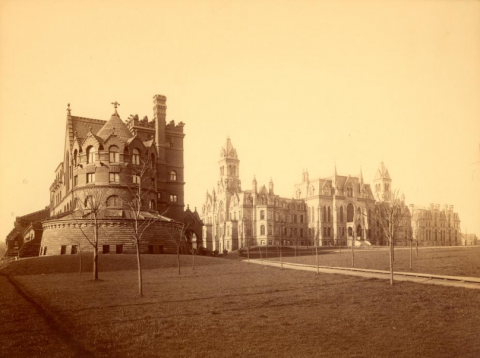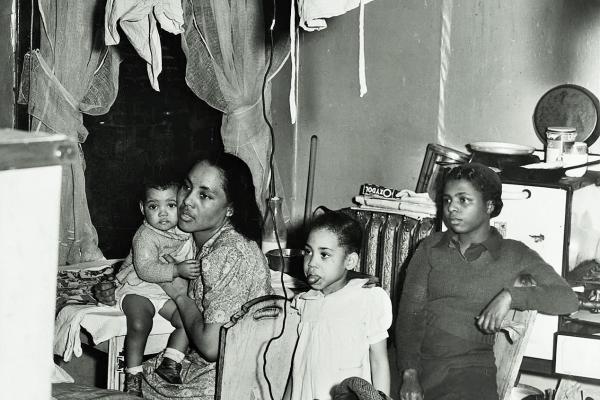Penn and the Almshouse
In 1872, the University of Pennsylvania relocated its small campus from the central City to Blockley Almshouse property that the City deeded to the University.
Two transfers of Blockley Almshouse property by the City to the University of Pennsylvania, the first in 1870, allowed the University to relocate its small central-City campus to West Philadelphia. College Hall, the first building on the site, opened in 1872, followed in 1874 by the Hospital of the University of Pennsylvania. In 1882, a second transfer of almshouse property gave Penn the land on which it would build the Museum of Archeology and Anthropology and Franklin Field, among other historic structures.
In 1854 “the vicinity of the almshouse was distinctly rural. West Philadelphia was sparsely settled. The old Market Street bridge [predating the Chestnut, Walnut, and South Street bridges] on the site of the more ancient ferry was the chief means of getting across the Schuylkill to the almshouse and hospital, although there was some ferriage from the east side to a wharf or landing on the almshouse grounds. Here and there near the almshouse farm were a few buildings for private business or public purposes, and a few wharves were located on both sides of the river.” The tracks and trestle of the Philadelphia and West Chester Railroad crossed the meadows of the bottomland on almshouse property the City had deeded to the railroad.[1] Of inestimably greater significance for the City’s future was the City’s prudent decision to sell a tract of ten acres to the University of Pennsylvania, to enable the University to relocate its central-City campus in West Philadelphia.
The historians John Puckett and Mark Lloyd briefly sketch the background of Penn’s purchase: “Penn’s founding dates to 1749, when Benjamin Franklin and his associates in Philadelphia organized an academy that became a Colonial college in 1755 and America’s first university in 1765. Spanning the Colonial, Revolutionary, Early Republic, Nationalist, Civil War, and Postbellum periods, the first half of Penn’s 275-year history took place in central-City Philadelphia, within walking distance of the Delaware River. In 1872, to escape the industrial City and a ‘vile neighborhood, growing viler every day,’ the University moved its small campus from 9th and Chestnut streets across the Schuylkill River to 34th and Walnut streets in the district of West Philadelphia, a partially settled, ‘emerging’ suburb of large estates and undeveloped crabgrass tracts, ornate mansions, villas and cottages, middle-class twins and working-class row houses.”[2]
On this site, a gently rising hill and downslope purchased in 1870, Penn would build its historic campus core, including the neo-Gothic serpentine-stone edifice of College Hall (1872)—and across Spruce Street, the Hospital of the University of Pennsylvania (HUP, 1874). Penn acquired forty-seven more acres of almshouse property in 1882, the deed of transfer this time accompanied by a City ordinance obligating the University “to provide ‘at least 50 free scholarships” to Philadelphia public school students ‘from time to time,’ no less than $7,500 annually.”[3] Thusly Penn’s trustees acquired the land on which they would erect the University Museum of Archeology and Anthropology (est. 1887-99) and Franklin Field (opened 1895), among other historic structures.
[1] John Welsh Croskey, compiler, History of Blockley: A History of the Philadelphia General Hospital from Its Inception, 1731–1928 (Philadelphia: F.A. Davis, 1929).
[2] John L. Puckett and Mark Frazier Lloyd, Becoming Penn: The Pragmatic American University, 1950–2000 (Philadelphia: University of Pennsylvania Press, 2015), 3.




